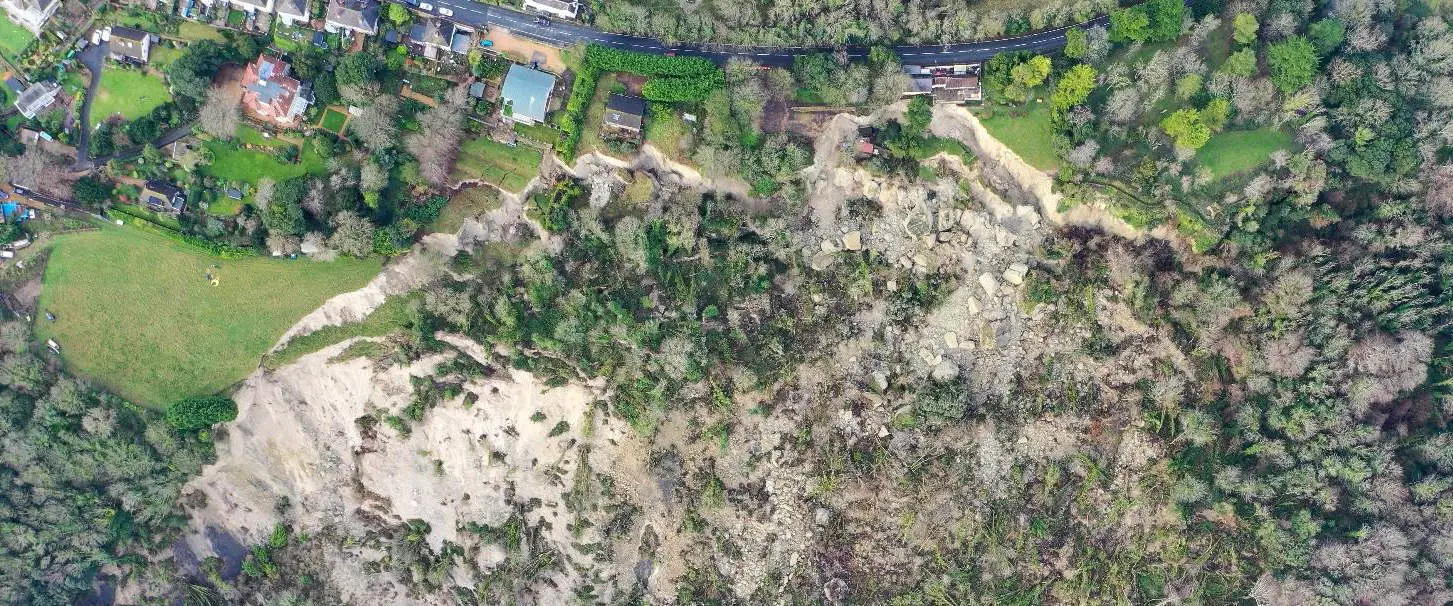Following a meeting last week between Isle of Wight council, Island Roads, local stakeholders and independent experts to discuss the re-closure of Leeson Road (due to the Bonchurch Landslide which took place in December 2023), a statement from Michelle Love, the council’s Service Director for Highways and Community Protection, has been circulating. among the community
The statement has been met with mixed reactions from local quarters.
Some have declared it a ‘scandal’, whilst others have offered measured responses to a continuing complex situation.
The statement, in Michelle Love’s words, follows below. Ed
Following the controlled re-opening of Leeson Road through the summer holiday period, under strict monitoring and continual inspection, to provide ongoing public safety, the previously published plan to close the road and carry out deep borehole drilling in three locations on the road, will be put in place on the evening of Sunday 8th September. The specialist team will then commence mobilisation on Monday 9th September as planned over the course of the last weeks and months.
The borehole operation is for two key purposes. The first is to investigate, log and sample the geological layers below Leeson Road, to further add to the data of the area following the catastrophic landslide/failure in December 2023. The second purpose is to then use the boreholes to house extensive monitoring equipment throughout the layers and depths of the boreholes, to return continually available data, that indicates various types of underground movement, groundwater levels and pore-water pressures. Seasonal rainfall patterns are a significant part of landslide activation as residents in Ventnor clearly appreciate.
As an addition to the immediate monitoring needs for Leeson Road, the boreholes will serve to provide additional geological information for other technical consultants and organisations that wish to use valuable, new data to inform studies on further work on the St Lawrence and Bonchurch landslide areas. This has resulted in adding scope to the works by drilling deeper in to the underground geological layers (around 130 m deep), to take best advantage of the works being carried out, and meeting the needs of not just the road investigations.
The drilling teams will be working weekends to try and ensure that the works can be completed earlier than fist anticipated. When the first set of data has been analysed the council and Island Roads will be able to decide if it is possible to reopen the road. The movement monitoring and sampling are key to inform a decision to reopen the road.
Safety of Teams and the Public
The risks associated with Leeson Road have been discussed a great deal and in several forums. As the seasons change again and we see increasing rainfall and storm events these risks increase. It is important to take the opportunity now that the summer holiday season is ending, to complete these works as quickly as possible.
The Isle of Wight Council and Island Roads were asked to look again at the possibility of opening the road to traffic under the previous controls, at the end of each daily operational shift. These specialist works must be completed in the daytime due to the nature of the operation.
The planning and development of safe and comprehensive systems of work, to operate deep drilling in a potentially fragile environment, has been completed by qualified and experienced engineers over several weeks and months. This results in a detailed and extensive method of working, risk assessment, hold-points and reviews.
Health & Safety legislation (The Health & Safety at Work Act and the Construction Design and Management Regulations) requires all organisations and individuals to take their part in reducing risk, managing safe operations, and to do this in a collaborative, open and well-communicated manner. These requirements include; client organisations and individuals, designers, contractors and workers. The principles have been developed and established in the UK over several decades and has very positively impacted safety standards and the safety levels for operators and those surrounding sites. Fundamental principles of H&S legislation require that safe places to work are provided for everyone.
Leeson Road is a constrained road, particularly in the section we are working, adjacent to the rear scarp of the December 2023 failure. The nature of the boreholes requires a specialist rig and the site needs to be planned around the safe operation of this key piece of equipment. This involves the separation, as much as possible, of people from plant and equipment. Safety zones around the equipment, and the required exclusion of people from the area is a fundamental part of the work. The details show that operators need 2.5m drilling rig width plus 2m either side of the rig which is a total of 6.5m. This is already wider than the available road width of 5.8m, which varies through this area from 5.8m to 6.2m, and will have to be carefully managed.
The minimum width for single lane traffic around a works site is 3.25m. (Lane width could be reduced to 3.0m in accordance with Chapter 8 legislation, but as the buses are generally 2.8m wide this does not work on bus / hgv routes.) Operators also require a 0.5m safety zone between vehicles and work area in accordance with Chapter 8. To facilitate both requirements without compromise would require a road width of 10.25m. It is not possible to have vehicles passing the rig within the exclusion zone. For the avoidance of doubt, all site personnel are excluded from this area with the rig operators being the only exception to this requirement.
Demobilisation options
The Council and Island Roads were asked to consider the possibility of daily de-mobilisation of all the equipment to an adjacent site or safe compound.
The ancillary equipment that is required for this type of specialist operation is also large and dedicated to an ongoing programme of continuous drilling, each hole taking many days to complete. To demobilise daily, it would be necessary to de-couple all ancillary equipment, remove drilling sections, re-load and store etc, break down the rig itself and then re-mobilise the next day, exactly re-siting the machinery in the same exact locations, levelling up again and re-establishing all the ancillary equipment.
This is not a normal way of operating for organisations in this specialist area and would add additional risk in carrying out lifting function. It is always the aim to optimise the time on site for the borehole works, and to demobilise daily to allow re-opening of the road would add significant amount of time for mobilisation and demobilisation. It is estimated that depending on how a deep a borehole has progressed, to remove equipment from site to allow safe access for vehicles, could range between 1 or 2 hours to 3 or 4 hours each day. In addition to the risks associated with adding activities that can otherwise be avoided, the timetable for completion would undoubtedly extend and extend well beyond the currently planned 12-weeks duration for the works.
With the constraints of the road dimensions and equipment sizes above, simply leaving the equipment in place and reopening the road to single file traffic is not possible, due to the clear proximity of heavy plant, albeit static and not operating, to moving traffic. Damage to vehicles or the specialist equipment would, in the operators mind, be inevitable and pose significant threats to safety and a loss of productivity to the overall programme, notwithstanding any potential repair times for specialist equipment.
Emergency vehicles and diversion route
Isle of Wight Council and Island Roads have also been asked to consider the possibility of ensuring less congested diversion routes around the Leeson Road closure and in particular in Wroxall and Newport Road.
Under the closure from the 8th September it will not be possible for emergency vehicles to proceed through the site and this has been discussed with those services. Consideration has been given to what measures can be taken to leave the diversion route in the above areas as free as possible for flowing traffic, particularly by potential parking suspensions on the route, to ensure both lanes are available to road-users and of course the emergency services.
IWC and Island Roads have looked further into the options, that are a balance between the efficient availability of the diversion route, and the amenity for local residents and communities given that parking normally used by them may be compromised. In Wroxall it is considered that a total parking suspension could not realistically be achieved due to the amenity needs locally, however a considered plan of partial suspensions, would provide much improved options for traffic to pull in across the road lengths and hence improve flows in potential tight spots. Given these partial suspension it is likely that any displaced parking could be accommodated. This will of course be monitored and amendments considered if; a) the local area for parking becomes increasingly unreasonable, or b) traffic flows and congestion do not build and cause significant problems once all of the measures are instigated.
For Newport Road it is considered that there are no realistic options for partial suspensions such as those above due to disabled accesses and school locations, and therefore it is intended to make a full parking suspension on Newport Road from Lowtherville Road through to St Margarets Glade. As above, this will be monitored and feedback considered in the overall balance of amenity and emergency access.
Traffic details
For information, traffic flows through the Leeson Road one-way operation were measured during August and sample information is included. This data of course shows the peak use of the road being during the day, but also shows the significant drop-off in volumes at the end of the working day.
As the data was also during the summer holiday season we would also expect to see generally lower flows in the off-season and particularly in the evenings when holiday-makers are not travelling around the Island. The flow data tends also to indicate that the net gain in amenity and use of opening Leeson Road again in the evenings and through the night, would not be significant.
It is hoped that with these important works planned out of the school holidays and operating the way it is planned, that the diversion route will be efficient for users and the emergency services, and the seasonal reductions in traffic build on this. All of the local network impacts and those in Newport Road and Wroxall will be monitored closely.
The Isle of Wight Council and Island Roads have worked in great detail throughout this very complex situation. While it is fully understood that local communities believe that the process is not efficient, this is a very complex situation following the catastrophic failure at the Landslip last December. As demonstrated by Environment Agency colleagues at the meeting of 4th September, engineering and coastal projects take a great deal of time and investment to investigate, design, consult upon, review, implement and deliver.
The Council and Island Roads remain committed to communicating with the Ventnor communities, be as clear as possible in how things are progressing and how they need to be delivered, and all parties will always strive to deliver things more quickly wherever the opportunities arise.





